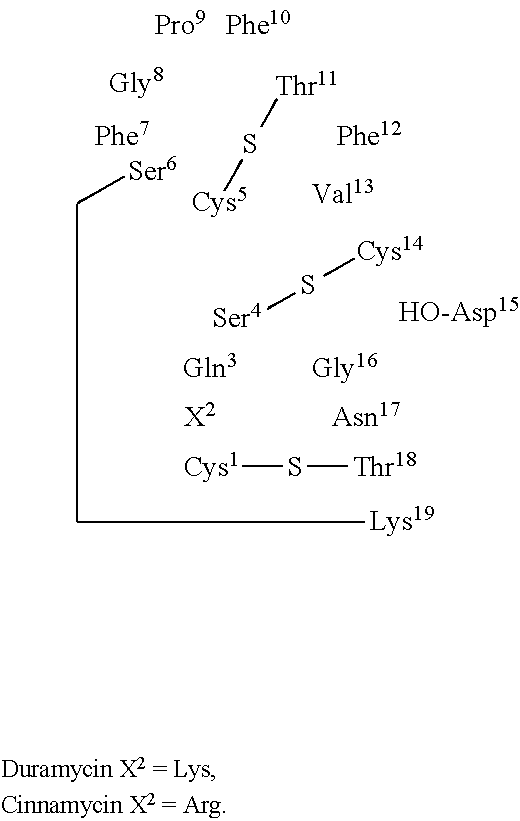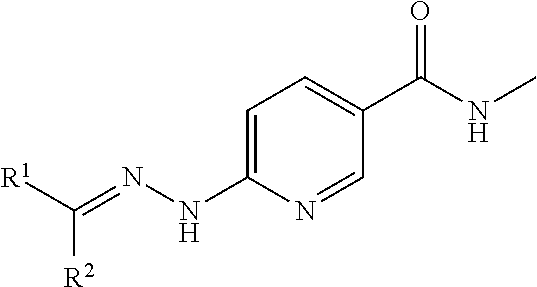Apoptosis imaging agents based on lantibiotic peptides
a technology of lantibiotic peptides and imaging agents, which is applied in the direction of peptides, peptides/protein ingredients, and therapy, etc., can solve the problem of inability to distinguish between apoptosis and necrosis
- Summary
- Abstract
- Description
- Claims
- Application Information
AI Technical Summary
Benefits of technology
Problems solved by technology
Method used
Image
Examples
example 1
Synthesis of 1,1,1-tris(2-aminoethyl)methane
Step 1(a): 3(methoxycarbonylmethylene)glutaric acid dimethylester
[0135]Carbomethoxymethylenetriphenylphosphorane (167 g, 0.5 mol) in toluene (600 ml) was treated with dimethyl 3-oxoglutarate (87 g, 0.5 mol) and the reaction heated to 100° C. on an oil bath at 120° C. under an atmosphere of nitrogen for 36 h. The reaction was then concentrated in vacuo and the oily residue triturated with 40 / 60 petrol ether / diethylether 1:1, 600 ml. Triphenylphosphine oxide precipitated out and the supernatant liquid was decanted / filtered off. The residue on evaporation in vacuo was Kugelrohr distilled under high vacuum Bpt (oven temperature 180-200° C. at 0.2 torr) to give 3-(methoxycarbonylmethylene)glutaric acid dimethylester (89.08 g, 53%).
[0136]NMR 1H(CDCl3): δ 3.31 (2H, s, CH2), 3.7 (9H, s, 3×OCH3), 3.87 (2H, s, CH2), 5.79 (1H, s, ═CH,) ppm.
[0137]NMR 13C(CDCl3), δ 36.56, CH3, 48.7, 2×CH3, 52.09 and 52.5 (2×CH2); 122.3 and 146.16 C═CH; 165.9, 170.0 and...
example 2
Preparation of 3-chloro-3-methyl-2-nitrosobutane
[0156]A mixture of 2-methylbut-2-ene (147 ml, 1.4 mol) and isoamyl nitrite (156 ml, 1.16 mol) was cooled to −30° C. in a bath of cardice and methanol and vigorously stirred with an overhead air stirrer and treated dropwise with concentrated hydrochloric acid (140 ml, 1.68 mol) at such a rate that the temperature was maintained below −20° C. This requires about 1 h as there is a significant exotherm and care must be taken to prevent overheating. Ethanol (100 ml) was added to reduce the viscosity of the slurry that had formed at the end of the addition and the reaction stirred at −20 to −10° C. for a further 2 h to complete the reaction. The precipitate was collected by filtration under vacuum and washed with 4×30 ml of cold (−20° C.) ethanol and 100 ml of ice cold water, and dried in vacuo to give 3-chloro-3-methyl-2-nitrosobutane as a white solid. The ethanol filtrate and washings were combined and diluted with water (200 ml) and coole...
example 3
Synthesis of bis[N-(1,1-dimethyl-2-N-hydroxyimine propyl)-2-aminoethyl]-(2-aminoethyl)methane (Chelator 1)
[0158]To a solution of tris(2-aminoethyl)methane (4.047 g, 27.9 mmol) in dry ethanol (30 ml) was added potassium carbonate anhydrous (7.7 g, 55.8 mmol, 2 eq) at room temperature with vigorous stirring under a nitrogen atmosphere. A solution of 3-chloro-3-methyl-2-nitrosobutane (7.56 g, 55.8 mol, 2 eq) was dissolved in dry ethanol (100 ml) and 75 ml of this solution was dripped slowly into the reaction mixture. The reaction was followed by TLC on silica [plates run in dichloromethane, methanol, concentrated (0.88 sg) ammonia; 100 / 30 / 5 and the TLC plate developed by spraying with ninhydrin and heating]. The mono-, di- and tri-alkylated products were seen with RF's increasing in that order. Analytical HPLC was run using RPR reverse phase column in a gradient of 7.5-75% acetonitrile in 3% aqueous ammonia. The reaction was concentrated in vacuo to remove the ethanol and resuspended i...
PUM
| Property | Measurement | Unit |
|---|---|---|
| Volume | aaaaa | aaaaa |
| Molar density | aaaaa | aaaaa |
| Fraction | aaaaa | aaaaa |
Abstract
Description
Claims
Application Information
 Login to View More
Login to View More - Generate Ideas
- Intellectual Property
- Life Sciences
- Materials
- Tech Scout
- Unparalleled Data Quality
- Higher Quality Content
- 60% Fewer Hallucinations
Browse by: Latest US Patents, China's latest patents, Technical Efficacy Thesaurus, Application Domain, Technology Topic, Popular Technical Reports.
© 2025 PatSnap. All rights reserved.Legal|Privacy policy|Modern Slavery Act Transparency Statement|Sitemap|About US| Contact US: help@patsnap.com



